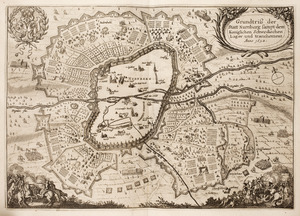Siege of Nuremberg facts for kids
Quick facts for kids Siege of Nuremberg |
|||||||
|---|---|---|---|---|---|---|---|
| Part of Thirty Years' War | |||||||
 Siege of Nuremberg (engraving by Matthäus Merian, 1642) |
|||||||
|
|||||||
| Belligerents | |||||||
| Commanders and leaders | |||||||
| Strength | |||||||
| 45,000 175 guns |
50,000 | ||||||
| Casualties and losses | |||||||
| 2,500 killed and wounded 10,000 died from disease 11,000 deserted |
900 killed and wounded Unknown total |
||||||
The siege of Nuremberg was a major event during the Thirty Years' War in 1632. It happened around the city of Nuremberg in what is now Germany. A siege is when an army surrounds a city or fort to cut off supplies and force it to surrender.
Contents
The Armies Gather in Nuremberg
In July 1632, Gustavus Adolphus of Sweden led the Swedish army. He faced a much larger enemy force. This enemy army was made up of soldiers from the Holy Roman Empire and the Catholic League. Their commanders were Albrecht von Wallenstein and Maximilian I.
Gustavus Adolphus decided to pull his army back. He moved them into the strong city of Nuremberg. Wallenstein's army quickly surrounded Nuremberg. They began to lay siege to the city. Their plan was to wait. They hoped that hunger and sickness would weaken the Swedish soldiers inside.
Challenges for the Besiegers
Keeping up the siege was very hard for Wallenstein's army. Nuremberg was a large city. It needed a huge number of soldiers to surround it completely. This surrounding line of troops is called a circumvallation.
Wallenstein's camp was enormous. It had about 50,000 soldiers. There were also 15,000 horses. Plus, about 25,000 camp followers were there. These were people who traveled with the army. Finding enough food and supplies for so many people and animals was extremely difficult. This is called foraging.
Meanwhile, Gustavus Adolphus's army grew stronger. Reinforcements arrived, bringing more soldiers. His army went from 18,500 to 45,000 men. They also had 175 field guns. This was the largest army Gustavus Adolphus ever commanded himself.
Life During the Siege
Life was tough for both sides during the siege. There was poor sanitation, meaning things were not clean. Supplies like food and medicine were also running low.
Many soldiers suffered from hunger. They also got sick with diseases like typhus and scurvy. Typhus is a serious infection. Scurvy is caused by not getting enough vitamin C.
The Battle of Alte Veste
To try and break the siege, Gustavus Adolphus decided to attack. On September 3, he led about 25,000 men. They attacked the Imperial army's strong defenses. This fight is known as the Battle of the Alte Veste.
However, the Swedish attack did not succeed. They could not break through the enemy lines. The Swedes lost about 2,500 men. The Imperial army lost around 900 soldiers.
The End of the Siege
The siege lasted for eleven weeks. Eventually, the Swedes and their allies decided to leave. They withdrew from Nuremberg.
Disease caused many casualties for the Swedish side. About 10,000 Swedish and allied troops died from sickness. Another 11,000 soldiers left the army. They simply deserted.
Gustavus Adolphus was very tired and weakened by the long struggle. He even sent messages to Wallenstein. He offered to make peace. But Wallenstein refused these offers. The siege ended without a clear winner.

